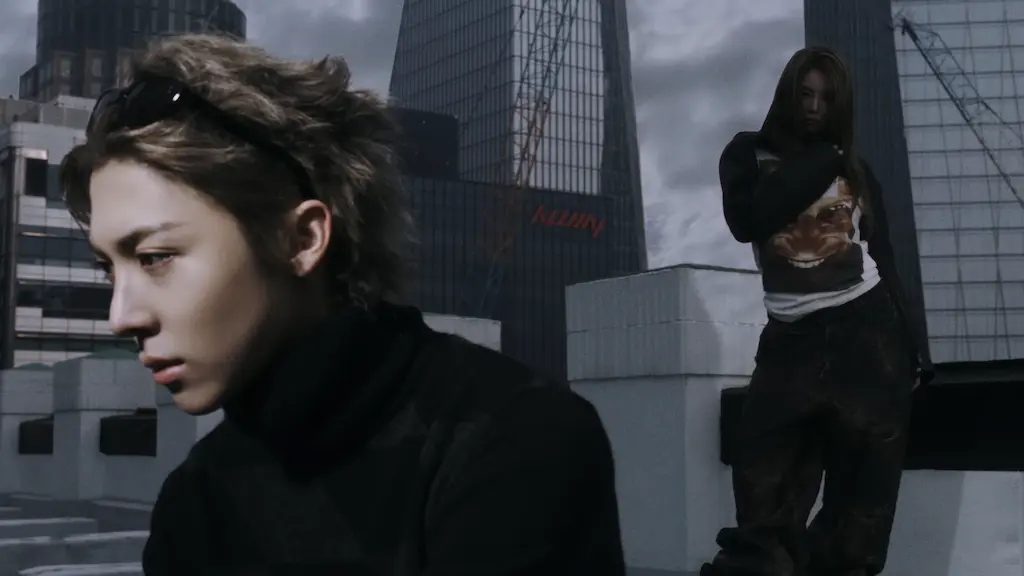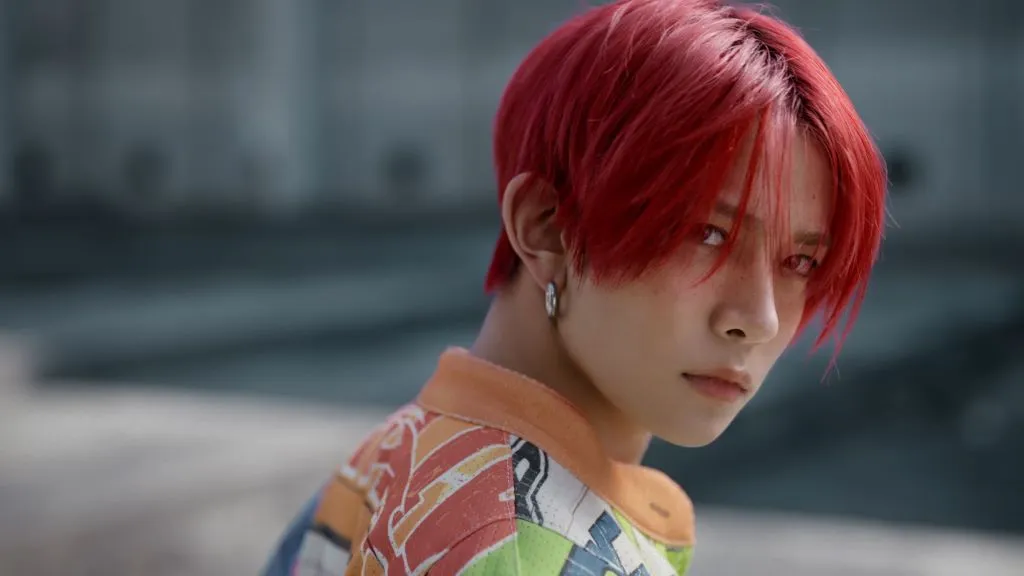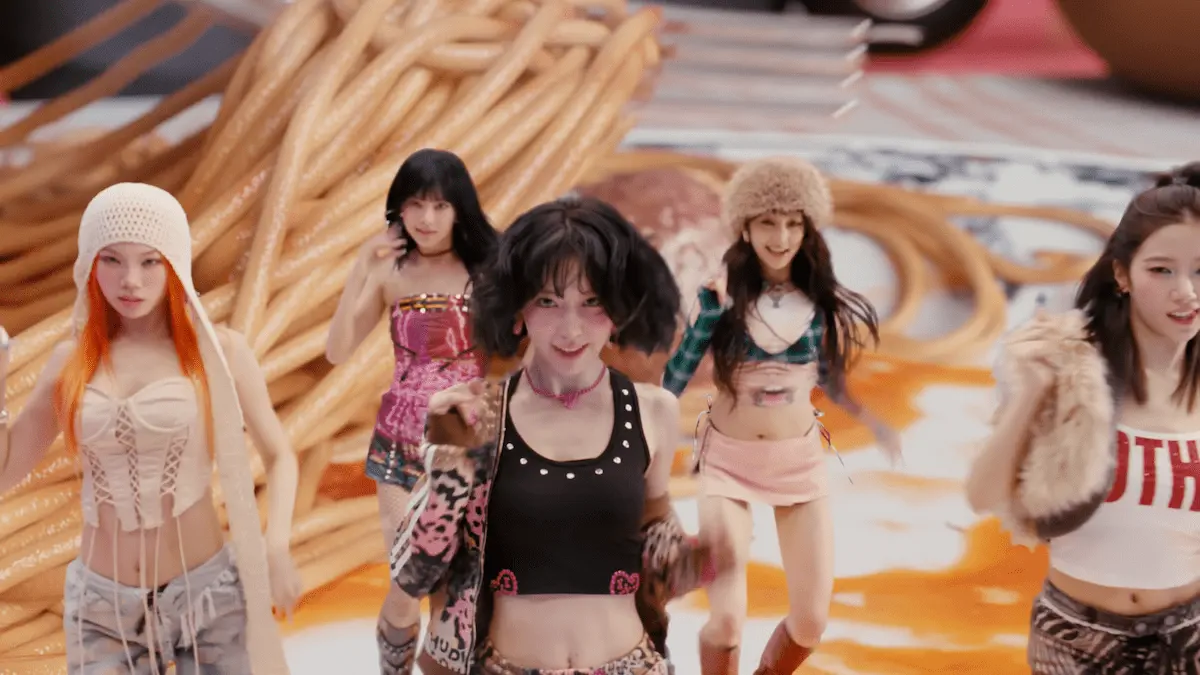ALLDAY PROJECT's 'FAMOUS' Explained: When Five Soloists Became One Group
I wasn’t expecting much from another co-ed group. The format has failed more times than it’s succeeded in K-pop, usually because agencies can’t resist turning it into a dating simulation or because the vocal ranges clash instead of complement. But FAMOUS grabbed me by the first chorus and didn’t let go.
What makes this work—and I had to watch it multiple times to articulate why—is that ALLDAY PROJECT doesn’t feel like a group. It feels like five solo artists who decided to collaborate, each bringing such a distinct vocal identity that you’re not watching members blend into a cohesive unit. You’re watching them take turns dominating the track.
That shouldn’t work. But it does. And after spending way too long analyzing this thing, I think I understand how Teddy pulled it off.

Source: Official THEBLACKLABEL YouTube (© THEBLACKLABEL)
Quick Navigation
- First Impression: The Structure That Shouldn't Work
- Credits & Context
- The Vocal Chemistry: Inverted Ranges
- The Tarzan Factor: Identity Anchor
- Why Youngseoul's Placement Matters
- The Visual Language: Dystopia Without Darkness
- The Hook's Paradox: "We Ain't Even Famous"
- Why This Works When Co-ed Usually Doesn't
- Q&A: Your Questions Answered
- Sources & Credits
First Impression: The Structure That Shouldn’t Work
The song is structured around solo sections. Not verses where multiple members trade bars—actual solo moments where one person holds the spotlight for 10-15 seconds while everyone else disappears.
At 0:19, Annie and Bailey open with low, breathy rap. At 0:48, Tarzan takes over completely. At 1:04, Youngseoul gets an isolated vocal moment. At 1:32, Woochan steps in. Then back to solo rotations.
This is risky. Most K-pop groups—especially debuts—try to establish unity and cohesion. Everyone gets a line, everyone’s in the shot, the harmony is the point. FAMOUS does the opposite. It says: here are five people who are individually compelling enough to carry sections alone.
That confidence either lands or crashes spectacularly. The fact that it landed tells you something about the casting.
Credits & Context
Artist: ALLDAY PROJECT
Song: “FAMOUS”
Release: June 16, 2025
Agency: THEBLACKLABEL (Teddy)
Director: RIMA YOON (RIGEND FILM)
Genre: Hip-Hop, R&B, Alternative Pop
Members: Annie, Bailey, Tarzan, Youngseoul, Woochan
What You Need to Know:
- This is THEBLACKLABEL’s first co-ed group (Teddy’s label, formerly YG producer)
- Bailey is a known choreographer, not trained idol
- Tarzan was a child actor (N분의1), re-emerging as hip-hop artist
- Youngseoul is the tonal outlier (more on that later)
- Woochan provides the “idol” vocal stability
The Numbers:
- 10M views in 4 days (no paid ads)
- 3 music show wins (M Countdown, Show! Music Core, Inkigayo)
- Comment section overwhelmingly Korean (domestic breakout before international)
- Audio pre-release strategy (MV dropped before music streaming)
That last point matters—the MV quality generated so much hype that people were watching it on loop before they could even stream the audio elsewhere. That’s old YG playbook, and it still works.
The Vocal Chemistry: Inverted Ranges
Here’s the detail that hooked me: the gender vocal ranges are inverted from expectation.
Typically, female vocalists sit higher in the mix, male vocalists anchor the low end. FAMOUS flips this:
Annie & Bailey (Female Rappers): Lower Register
At 0:19-0:45, both deliver in a lower, more relaxed vocal placement. Not trying to hit high notes or add brightness. They’re sitting in a conversational, almost lazy pocket that’s closer to male rap delivery.
This creates space in the upper register for—
Tarzan & Woochan (Male Vocalists): Higher Register
Tarzan at 0:48 and Woochan at 1:32 aren’t doing typical male rap growls. They’re higher, clearer, more melodic. Tarzan especially has this tone that reads as young and slightly nasal in a way that cuts through rather than sits under.
This inversion is brilliant because it means nobody’s fighting for the same sonic space. The female and male voices don’t blend—they alternate, creating natural dynamic shifts.
And then you have—
Youngseoul: The Tonal Reset
At 1:04 and throughout the chorus, Youngseoul’s tone is noticeably brighter, clearer, more “traditionally K-pop” than anyone else. Comments kept calling her voice “refreshing” or saying she “ventilates” the track when it gets too heavy.
That’s exactly right. She’s the pressure release valve. When the low-register rap threatens to make everything too dense, her tone lifts it back up. It’s not about skill—it’s about strategic tonal placement.
The Tarzan Factor: Identity Anchor
Let me talk about Tarzan for a second because he’s doing something specific that holds the entire group’s identity together.
At 0:48-1:03, his section has this loose, almost nonchalant delivery. He’s not trying to sound polished. The flow is conversational, the tone is casual, there’s even a slight rasp that makes him sound like he just woke up.
In a landscape of perfectly trained K-pop vocalists, that roughness reads as authenticity. Whether it is or isn’t doesn’t matter—it reads that way. And in a debut that could easily feel manufactured (five members, big label, high budget), having one voice that sounds unpolished grounds everything else.
Multiple comments specifically called him the “identity member” of the group, and I agree. He’s the element you can’t replicate by just training someone harder. He’s got a natural tone and delivery style that defines the group’s vibe as “hip-hop first, K-pop second.”
Watch 2:08 where there’s actual partner choreography between members—they’re looking at each other, not just dancing in the same space. That physical chemistry works because Tarzan and the female members don’t feel like they’re in different sonic universes. The inverted vocal ranges mean he can duet with Annie without either one overpowering the other.
Why Youngseoul’s Placement Matters
Youngseoul’s role is fascinating because on paper, she’s the least “necessary” member. The hip-hop vibe is carried by the rappers. The vocal skill is covered by Woochan. The visual distinctiveness comes from Tarzan and Bailey.
So why does removing her from the track (I tried this mentally) make everything collapse?
Because she’s the edit point. Every time the song threatens to become monotonous in its low-register cool, she resets the tone. At 1:04, right when you’re settling into the rap groove, her voice comes in and suddenly you’re in a different song. Then at 1:15, we’re back to rap.
That constant shifting—low to high, rap to vocal, dense to airy—creates a push-pull dynamic that keeps your attention locked. You can’t zone out because the energy keeps changing.
Her tone is also the most recognizable. In a track where four other voices are deliberately keeping things low and understated, hers pops. That memorability matters for a debut. People need sonic landmarks to latch onto.
The Visual Language: Dystopia Without Darkness
Director RIMA YOON made interesting choices here that could’ve gone wrong but didn’t.
The MV opens with 0:00-0:15: aerial shot descending through clouds to a rooftop. Classic “we’re above it all” framing. Then immediately into dark, industrial spaces—chains, concrete, harsh lighting.
This is dystopian visual language, which is well-trodden territory. But here’s the thing: it never gets actually dark. Even in the “gritty” scenes, there’s always light. The color grading is muted but not depressing. The industrial spaces feel expensive rather than abandoned.
At 0:27, there’s a shattered glass motif that recurs throughout (2:56 especially). Normally, shattered glass = breakdown/destruction. Here, it’s framed as breakthrough. The glass explodes outward, not inward. It’s barrier-breaking, not self-destruction.
The Car Crash Sequence (0:35-0:50)
This could’ve been gratuitous—cars exploding in a tunnel, stunt choreography, high-budget flex. But watch how it’s shot: the crashes happen behind or around the members, not to them. They’re walking through chaos unbothered.
That’s the visual thesis: the world can be falling apart, but we’re untouchable. It’s not about causing the chaos (aggression) or surviving it (victimhood). It’s about being so focused on your own trajectory that external chaos is just scenery.
The Cloud Sequence (2:30-3:00)
The final sequence in the clouds is where the MV fully commits to its “ascension” narrative. We’ve gone from rooftop → industrial underground → tunnel explosions → above the clouds.
It’s a literal rise, but the editing is interesting. They don’t show them getting there. No climbing, no struggle montage. They’re just suddenly there. The implication: the rise was inevitable. The journey wasn’t worth showing because the outcome was never in doubt.
That’s either confident or arrogant, depending on your perspective. For a debut, it’s bold.
The Hook’s Paradox: “We Ain’t Even Famous”
The central hook—“We ain’t even famous but they want to be us”—is doing clever work.
On the surface, it’s ironic. They’re literally debuting, so by definition they’re not famous yet. But saying “people want to be us anyway” is a flex: our aura precedes our achievements.
But there’s a second layer. In an industry obsessed with metrics—chart positions, view counts, brand rankings—this hook says: those metrics aren’t what make you worth emulating. Authenticity, style, confidence—those come first. Fame follows.
At 0:48 and 1:40, the hook hits right after the most distinctive solo sections (Tarzan and Bailey respectively). That sequencing is intentional. You just heard something that doesn’t sound like anyone else, and then they tell you “we ain’t even famous.” The implication: imagine what happens when we are.
It’s aspirational without being desperate. They’re not begging for attention—they’re confidently asserting they already have something worth wanting.
Why This Works When Co-ed Usually Doesn’t
Co-ed groups typically fail for one of three reasons:
- Forced romantic chemistry (makes it awkward, limits choreography)
- Vocal range conflicts (male and female voices fighting for space)
- Concept confusion (can’t decide if it’s a boy group or girl group aesthetic)
FAMOUS sidesteps all three:
1. Zero Romantic Framing
At 2:08, the partner choreography isn’t romantic—it’s competitive. They’re facing each other like rivals, not love interests. The energy is “who’s cooler” not “who likes who.”
Comments kept saying variations of “no romance vibes, just everyone trying to be the most stylish.” That’s the correct read, and it’s refreshing. They’re peers, not potential couples.
2. The Inverted Range Solution
By putting female voices low and male voices higher, they created complementary rather than competing tones. This is the technical breakthrough that makes the format work musically.
3. “Cool” as the Unifying Aesthetic
The concept isn’t “boy group” or “girl group”—it’s “effortlessly cool people in a room”. That gender-neutral framing means styling, choreography, and attitude can be consistent across all five members without anyone looking out of place.
Bailey in particular benefits from this. As a choreographer transitioning to performer, she doesn’t have to suddenly adopt “girl group” mannerisms. She can just be… cool. That’s the lane.
The Age Factor
All five members are adults. No high school concepts, no “youth” narrative. They’re presented as professionals who know what they’re doing. That maturity allows them to stand next to each other without the “oppa/unnie” dynamic that would make interactions awkward.
Q&A: Your Questions Answered
Why is Tarzan getting so much attention?
Tarzan anchors the group's identity as hip-hop-first rather than K-pop-with-rap-elements. His vocal tone is rough, conversational, and unpolished in ways that read as authentic. In a debut that could feel overly manufactured, he's the element that feels organic. His presence also signals that this isn't trying to be a typical idol group—the hip-hop credibility is central, not decorative. Plus, his voice is genuinely distinctive in a way you can't train someone into.
What makes the co-ed format work here when it usually fails?
Three things: inverted vocal ranges (females low, males high) so nobody fights for sonic space; zero romantic framing (they're competitors, not potential couples); and a gender-neutral "cool" aesthetic that doesn't force members into typical boy/girl group roles. Also, they're all adults, which removes the awkward age-gap dynamics that plague other co-ed attempts. The chemistry reads as professional respect rather than manufactured closeness.
Why does Youngseoul's voice stand out so much?
Strategic contrast. Everyone else is sitting in lower, understated registers. Her brighter, clearer tone creates reset points throughout the track—when things get too heavy in the low-register rap sections, she lifts it back up. She's not the strongest vocalist or the best rapper, but her tonal placement is the edit point that keeps the song from becoming monotonous. Remove her and the track collapses into low-end density.
What does "we ain't even famous" actually mean?
It's a paradox. Surface level: we're debuting, so literally not famous, but people already want to be like us—aura precedes achievement. Deeper: in an industry obsessed with metrics, this says the metrics aren't what make you worth emulating. Confidence, style, authenticity come first. Fame is a byproduct, not the goal. It's aspirational without being desperate. They're not begging for attention; they're asserting they already have something valuable.
Is the solo structure sustainable long-term?
That's the big question. Right now, the "five soloists collaborating" approach works because it's novel and each member is distinct enough to hold their sections. But will audiences want more blending and group cohesion as they mature? Or will they double down on the solo distinctiveness? The risk is that if one member's section doesn't land, the whole track feels uneven. The upside is that each member has space to develop a personal fanbase. It's high-risk, high-reward structure.
How does this compare to other THEBLACKLABEL releases?
This is more restrained than typical Teddy production. There's no maximalist drop, no overwhelming bass, no vocal pyrotechnics. It's built on groove and space rather than impact. That's a smart choice for a debut—it lets the members' individual tones be the focus rather than getting buried under production. It also differentiates ALLDAY PROJECT from BLACKPINK (whom Teddy also produced). Where BLACKPINK is explosive confidence, ALLDAY PROJECT is understated cool. Different lane, less direct comparison.
Sources & Credits
Primary Sources:
- ALLDAY PROJECT “FAMOUS” Official MV - YouTube
- Korean YouTube comments analysis (June 2025)
- Music show performance data
Chart Performance:
- 10M views in 4 days (organic, no paid promotion)
- 3 music show wins (M Countdown, Music Core, Inkigayo)
- Top 0.5% listener badge achievement (pre-streaming release)
- Domestic breakout (Korean comments dominated early discourse)
Production Credits:
- Director: RIMA YOON (RIGEND FILM)
- Producer: Teddy (THEBLACKLABEL)
- Label: THEBLACKLABEL
- Release: June 16, 2025
- Genre: Hip-Hop, R&B, Alternative Pop
Member Profiles:
- Annie: Female rapper, low-register specialist
- Bailey: Choreographer-turned-performer, visual anchor
- Tarzan: Former child actor, hip-hop identity anchor, distinctive vocal tone
- Youngseoul: Tonal reset point, brightness contrast
- Woochan: Vocal stability, melodic high register
Key Observations:
- Inverted vocal ranges (females low, males high)
- Solo-section structure (high-risk format)
- Zero romantic framing (peer competition instead)
- Dystopian visuals without actual darkness
- “We ain’t even famous” paradox as core message




Comments